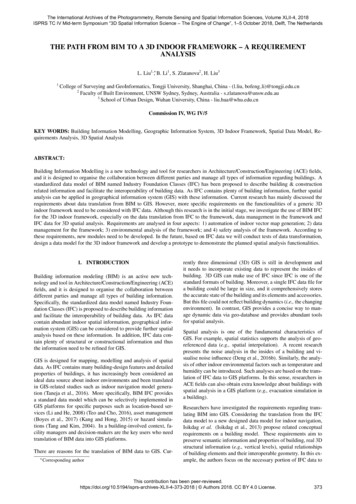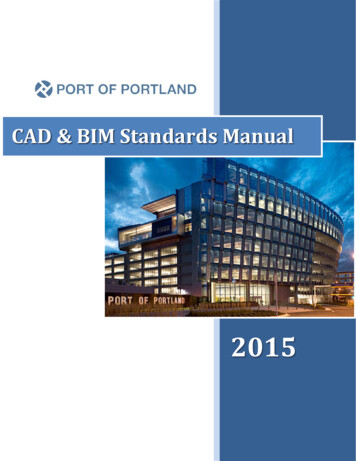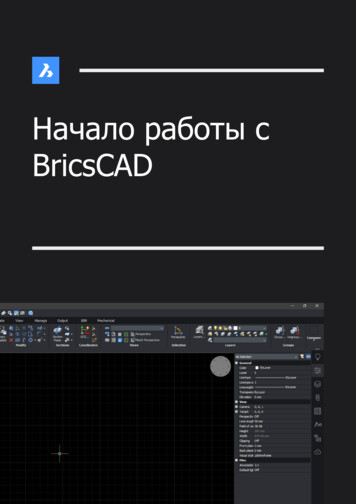
Transcription
The International Archives of the Photogrammetry, Remote Sensing and Spatial Information Sciences, Volume XLII-4, 2018ISPRS TC IV Mid-term Symposium “3D Spatial Information Science – The Engine of Change”, 1–5 October 2018, Delft, The NetherlandsTHE PATH FROM BIM TO A 3D INDOOR FRAMEWORK – A REQUIREMENTANALYSISL. Liu1, , B. Li1 , S. Zlatanova2 , H. Liu31College of Surveying and GeoInformatics, Tongji University, Shanghai, China - (l.liu, bofeng li)@tongji.edu.cn2Faculty of Built Environment, UNSW Sydney, Sydney, Australia - s.zlatanova@unsw.edu.au3School of Urban Design, Wuhan University, China - liu.hua@whu.edu.cnCommission IV, WG IV/5KEY WORDS: Building Information Modelling, Geographic Information System, 3D Indoor Framework, Spatial Data Model, Requirements Analysis, 3D Spatial AnalysisABSTRACT:Building Information Modelling is a new technology and tool for researchers in Architecture/Construction/Engineering (ACE) fields,and it is designed to organise the collaboration between different parties and manage all types of information regarding buildings. Astandardized data model of BIM named Industry Foundation Classes (IFC) has been proposed to describe building & constructionrelated information and facilitate the interoperability of building data. As IFC contains plenty of building information, further spatialanalysis can be applied in geographical information system (GIS) with these information. Current research has mainly discussed therequirements about data translation from BIM to GIS. However, more specific requirements on the functionalities of a generic 3Dindoor framework need to be considered with IFC data. Although this research is in the initial stage, we investigate the use of BIM IFCfor the 3D indoor framework, especially on the data translation from IFC to the framework, data management in the framework andIFC data for 3D spatial analysis. Requirements are analysed in four aspects: 1) automation of indoor vector map generation; 2) datamanagement for the framework; 3) environmental analysis of the framework; and 4) safety analysis of the framework. According tothese requirements, new modules need to be developed. In the future, based on IFC data we will conduct tests of data transformation,design a data model for the 3D indoor framework and develop a prototype to demonstrate the planned spatial analysis functionalities.1. INTRODUCTIONBuilding information modeling (BIM) is an active new technology and tool in Architecture/Construction/Engineering (ACE)fields, and it is designed to organise the collaboration betweendifferent parties and manage all types of building information.Specifically, the standardized data model named Industry Foundation Classes (IFC) is proposed to describe building informationand facilitate the interoperability of building data. As IFC datacontain abundant indoor spatial information, geographical information system (GIS) can be considered to provide further spatialanalysis based on these information. In addition, IFC data contain plenty of structural or constructional information and thusthe information need to be refined for GIS.GIS is designed for mapping, modelling and analysis of spatialdata. As IFC contains many building-design features and detailedproperties of buildings, it has increasingly been considered anideal data source about indoor environments and been translatedin GIS-related studies such as indoor navigation model generation (Taneja et al., 2016). More specifically, BIM IFC providesa standard data model which can be selectively implemented inGIS platforms for specific purposes such as location-based services (Li and He, 2008) (Teo and Cho, 2016), asset management(Boyes et al., 2017) (Kang and Hong, 2015) or hazard simulations (Tang and Kim, 2004). In a building-involved context, facility managers and decision-makers are the key users who needtranslation of BIM data into GIS platforms.There are reasons for the translation of BIM data to GIS. Cur Correspondingauthorrently three dimensional (3D) GIS is still in development andit needs to incorporate existing data to represent the insides ofbuilding. 3D GIS can make use of IFC since IFC is one of thestandard formats of building. Moreover, a single IFC data file fora building could be large in size, and it comprehensively storesthe accurate state of the building and its elements and accessories.But this file could not reflect building dynamics (i.e., the changingenvironment). In contrast, GIS provides a concise way to manage dynamic data via geo-database and provides abundant toolsfor spatial analysis.Spatial analysis is one of the fundamental characteristics ofGIS. For example, spatial statistics supports the analysis of georeferenced data (e.g., spatial interpolation). A recent researchpresents the noise analysis in the insides of a building and visualise noise influence (Deng et al., 2016b). Similarly, the analysis of other indoor environmental factors such as temperature andhumidity can be introduced. Such analyses are based on the translation of IFC data to GIS platforms. In this sense, researchers inACE fields can also obtain extra knowledge about buildings withspatial analysis in a GIS platform (e.g., evacuation simulation ina building).Researchers have investigated the requirements regarding translating BIM into GIS. Considering the translation from the IFCdata model to a new designed data model for indoor navigation,Isikdag et al. (Isikdag et al., 2013) propose related conceptualrequirements on a building model. These requirements aim topreserve semantic information and properties of building, real 3Dstructural information (e.g., vertical levels), spatial relationshipsof building elements and their interoperable geometry. In this example, the authors focus on the necessary portion of IFC data toThis contribution has been es-XLII-4-373-2018 Authors 2018. CC BY 4.0 License.373
The International Archives of the Photogrammetry, Remote Sensing and Spatial Information Sciences, Volume XLII-4, 2018ISPRS TC IV Mid-term Symposium “3D Spatial Information Science – The Engine of Change”, 1–5 October 2018, Delft, The Netherlandsmeet indoor navigation requirements. Another review paper discusses the interoperability of BIM and GIS (Liu et al., 2017), andit categorises the integration of BIM and GIS into three levels,i.e., data, process and application. It also reviews the data models to preserve the complete information in both IFC and GIS witha generic ontology. For a GIS platform, this review paper mainlyshows the requirements on data translation and incorporation ofIFC.However, more specific requirements need to be clarified for GISapplications with IFC data, i.e., how to use the data convertedfrom IFC and what are the analysis functionalities? For these applications, we consider a generic 3D indoor framework which canprovide the modelling and analysis functionalites on 3D objectsin indoor environments. Although this research is in the initialstage, this paper aims to reveal the requirements about the 3Dindoor framework. In general, this framework is designed to incorporate 3D indoor modelling with spatial analysis. Thus BIMIFC can support this framework at least in the following aspects:1) indoor vector maps; 2) data management of the framework; 3)indoor environmental analysis; and 4) emergency scenario simulation such as fire proliferation. So far there is no generic solutionwhich can completely address the above topics. In this paper weconduct a requirement analysis focusing on the four aspects, andexplain potential application scenarios with examples.This paper is organised as follows. Section 2 will present a briefbackground on the relationship between BIM and GIS, whichgives the big picture of current GIS applications with IFC data.Section 3 will present a requirement analysis on the four aspects.Subsection 3.1 introduces the need of automatic generation ofvector map from IFC data; subsection 3.2 discusses the requirements on data management of the framework; subsection 3.3presents the need for indoor environmental analysis such as thedistribution of noise or temperature; and subsection 3.4 providesthe requirements on indoor safety analysis such as fire diffusion.Section 4 concludes this paper with some future work.2. BACKGROUNDSo far the most concerned topic is the data interoperability between IFC and other data models in GIS domain. For instance,there are reported studies on mapping IFC to CityGML data(Cheng et al., 2013) (Deng et al., 2016a). CityGML (City Geography Markup Language) is an Open Geospatial Consortium(OGC) standard and it is used as a common information modelfor geometric and semantic representations of 3D urban objects(Gröger et al., 2012). Cheng et al. (Cheng et al., 2013) discuss thetransformation from IFC geometry of Constructive Solid Geometry (CSG) to Boundary Representation (B-Rep) in CityGML. Butthere is no comprehensive standard to bridge IFC and GIS-relateddata models, mostly because these standards are developed fordifferent purposes in spite of their correlations.The overlap between BIM and GIS lays on the ’building’ notion. But the integration of BIM and GIS is not required for everybuilding-related application. Specifically, the developing 3D GIScan benefit from the development of BIM technologies. Naturally IFC data are applied to visualisation of building insides (Arslan et al., 2014). Some research regards IFC data as 3D indoorbackground (Costin and Teizer, 2014) (Arslan et al., 2014). Studies regarding indoor navigation emphasize the 3D geometry ofBIM data and generate accurate indoor maps (Li and He, 2008)(Teo and Cho, 2016) (Wu and Zhang, 2016) (Diakité and Zlatanova, 2018). In this study, the navigation network representingthe accessible path network is derived from the 2.5D floor mapsextracted from the 3D geometric elements in BIM. Indoor positioning and localisation can also benefit from BIM data. Thegeometry in BIM data serves as a constraint to improve indoorlocalisation results. Tomasi et al. (Tomasi et al., 2015) show theanalysis functionality for the deployment of positioning sensorsin a building.3D spatial query is a pivotal feature of 3D GIS and it can beapplied to the information extracted from BIM data. Boyes etal. (Boyes et al., 2017) propose a combined use of BIM andGIS for asset management. They aim for location-based queries(”objects in a space” or ”the asset data regarding this location”).The authors prefer to convert BIM data to a GIS platform. Kangand Hong (Kang and Hong, 2015) propose a method to extractgeometric shapes and element properties from IFC data to GIS interms of facility management. Irizarry et al. (Irizarry et al., 2013)combine BIM and GIS to support supply chain management ofconstruction suppliers. Fosu et al. (Fosu et al., 2015) suggestto maintain asset database to monitor the energy consumption ofbuildings.Liu et al. (Liu et al., 2017) categorise the integration of BIMand GIS into three levels: data level, process level and application level. On the data level, as BIM IFC contains much moredetails of buildings than the building-related data models in GISdomain, research is normally conducted on the translation fromIFC to these GIS-related data models (e.g., CityGML). For sucha translation, researchers have to select and simplify the schemaof IFC for applications. On the process level, a generic ontologycan be created for both BIM and GIS domains. This method isflexible but it is still under development; on the application level,intermediate information is adopted to connect BIM and GIS fora specific problem. However, this categorisation concentrates onthe data interoperability but not on different roles of BIM andGIS.Several review papers stress the analysis functionalities of GIS(Fosu et al., 2015) (Liu et al., 2017). They identify the fact thatBIM data provide accurate models to a GIS platform for spatialenvironmental analysis. Stoter et al. (Stoter et al., 2008) visualise and quantify noise influence around the façade of a building,which is a typical measure in a GIS platform. A further implementation has extended the noise analysis into the insides of abuilding (Deng et al., 2016b).As BIM IFC comprehensively defines building elements withtheir properties and their relationships, it is an ideal data modelfor indoor dynamics simulation and analysis. In a study aboutsimulations for building design, Tang and Kim (Tang and Kim,2004) initially discuss different types of simulation for buildingsin an analysis platform. These simulation scenarios include energy simulation such as thermal or solar shadow mapping, airflow analysis, the movement of fire and smoke dynamics, occupant evacuation in a 3D environment, indoor light analysis,etc. All these analyses and simulations correspond to physicalproperties of building elements and their materials. It is notedthat these analyses are conducted with a toolkit (Tang and Kim,2004), which indicates outside analysis plug-in can complementCAD software to enrich analysis functionalities. Similarly, witha toolkit Dimyadi et al. (Dimyadi et al., 2007) generate fire diffusion information based on IFC data. During this procedure, theauthors also extract the geometric and topological information ofbuilding from the IFC data.This contribution has been es-XLII-4-373-2018 Authors 2018. CC BY 4.0 License.374
The International Archives of the Photogrammetry, Remote Sensing and Spatial Information Sciences, Volume XLII-4, 2018ISPRS TC IV Mid-term Symposium “3D Spatial Information Science – The Engine of Change”, 1–5 October 2018, Delft, The NetherlandsIn general, the active research directions regarding both BIM andGIS include: 1) indoor navigation. Navigation networks can bederived based on the geometry and semantics of IFC (Li and He,2008) (Teo and Cho, 2016); 2) location-based services. It includes indoor localisation and asset/facility management (Boyeset al., 2017) (Kang and Hong, 2015); 3) layout planning. Layout planning can be applied for the computation of the optimalcoverage of wireless sensors or lights (Tomasi et al., 2015); 4)environmental analyses, such as energy consumption analysis,shadow analysis (Rafiee et al., 2014), and noise analysis (Stoteret al., 2008) (Deng et al., 2016b); and 5) dynamic factor analyses. Such analyses can be fire/smoke simulation and evacuationanalysis (Tang and Kim, 2004).Regarding the different roles of BIM and GIS, currently thegeneral opinion emphasizes the analysis ability of GIS and accurate building-design features and detailed properties of BIM(Irizarry et al., 2013) (Wu and Zhang, 2016). Barazzetti andBanfi (Barazzetti and Banfi, 2017) indicate BIM software haslimited processing ability on geo-spatial data. The authors introduce a practical tool Autodesk Infrawork issued by Autodesk,Inc. to support BIM processes. Autodesk Infrawork can handleboth raster (e.g., aerial/satellite images) and vector (e.g., TIN)formats. It also provides a connection to data from ArcGIS (thefamous GIS software set of Esri, Inc.) and thus building data canbe geo-referenced. Therefore, it is not difficult to load and visualise geo-spatial data for BIM software. But more geo-spatialqueries/analyses are required to interpret and comprehend indoordynamics and phenomena. We argue that the research focus regarding BIM to GIS can be shifted to more practical topics, i.e., todevelop and optimise more spatial analysis functionalities whichcan facilitate the use of BIM information. In the following section, we will present a requirement analysis on a generic 3D indoor framework which aims to integrate 3D models with spatialanalysis functionalities.Figure 1. Illustration of indoor vector map generationsingle floors, but they either symbolise the vertical passage ormanually outline its shape.Another important issue is the validation of the geometry of IFCmodels. As IFC models are manually created, it is possible toinvolve some topological/geometric errors (e.g., overlap). For thepurpose of indoor navigation, a recent study has provided a testfor geometric data validation of IFC data (Diakité and Zlatanova,2016). The geometry of IFC need to be checked and validatedbefore indoor maps and navigation networks are derived.Therefore, the requirements for the generation of indoor vectormap are listed as follows:3. REQUIREMENTS ANALYSIS Develop a complete automation method to transform 3D geometry in IFC to indoor maps.In this section, we present the requirement analysis about the development of a generic 3D indoor framework on IFC information.These requirements mainly cover four topics: 1) automation ofindoor vector map from IFC; 2) data management regarding spatial analysis; 3) environmental analysis based on IFC information; and 4) indoor safety analysis based on IFC information. Validate geometric data in IFC for the generic 3D indoorframework.3.1Indoor Vector MapVector map is a basic input for GIS platforms. As BIM IFC provides accurate 3D models of building with precise dimensions,it has the potential to be automatically transferred to indoor vector maps. In this case, floor plans (i.e., the vector map) can bederived on each storey according to CSG geometric elements.Many researchers have utilised IFC data to facilitate the automation of indoor vector maps. A major problem with these methodsis that they cannot conduct a complete automation since they cannot handle some complicated 3D geometric shapes (e.g., staircaseor escalator). For example, a spiral staircase consisting of manysteps is non-trivial for GIS data management.Figure 1 presents an example of indoor maps derived from IFCdata. The stair (consisting of solids, see the upper part) are converted to a 3D surface geometry in the 3D indoor framework (seethe bottom part). At present the existing methods for navigationnetwork generation always automatically derive flat network in3.2Data ManagementThe requirement for indoor data management is to organise geometric and semantic data of building and its properties in a concise and effective way. Considering the functionalities of the3D indoor framework, it is not designed to process all kinds ofqueries about building. We argue that this 3D indoor frameworkcan leave design and construction data to BIM software, but onlyfocuses on the analysis functionality on building with its geospatial context. Based on the current implemented data models inGIS, extension modules can be added to absorb new informationtypes from BIM IFC.All the data converted from BIM IFC need to be managed in anappropriate way. Many BIM classes are new to GIS and they canbe introduced to the design of new GIS data models. Therefore,the corresponding new data models should aim for data storagefor different applications. For instance, several classes definedin the domain specific data schemas of IFC can be transformedto the 3D indoor framework, i.e., IfcHvacDomain, IfcPlumbingFireProtectionDomain, IfcElectricalDomain, and IfcBuildingControlsDomain. IfcHvacDomain schema involves the conceptsThis contribution has been es-XLII-4-373-2018 Authors 2018. CC BY 4.0 License.375
The International Archives of the Photogrammetry, Remote Sensing and Spatial Information Sciences, Volume XLII-4, 2018ISPRS TC IV Mid-term Symposium “3D Spatial Information Science – The Engine of Change”, 1–5 October 2018, Delft, The Netherlandsin the heating, ventilating and air conditioning (HVAC) domain;IfcPlumbingFireProtectionDomain schema defines concepts related to plumbing and fire protection. It relates to terminal pointsor hydrants for extinguishing fire, which can support fire simulation; and IfcElectricalDomain schema includes cabled systemsfor electrical supply, which can be applied to energy consumptionanalysis. In addition, in the shared element data schemas of IFC,IfcSharedFacilitiesElements schema provides basic concepts forfacilities management (FM); and IfcSharedBldgServiceElementsschema relates to property sets of flow and distribution systems,e.g., fluid-flow properties, electrical properties and thermal properties. All these properties relate to indoor environments and theycan be stored in the 3D indoor framework for spatial analysis. Tokeep the integrity and independence of data, a generic data modelcan be designed for different applications. For example, pipelinescan be converted and stored with air-related data (ventilation andpressure), and thus air flow can be analysed and visualised in the3D indoor framework. Similarly, other building data (e.g., materials) for safety analysis can also be appropriately organised forneeded application analysis.A conceptual mapping of BIM information to the 3D indoorframework is given in Figure 2. Four components of IFC data,geometry, semantics, relationships and properties of building elements, are converted into the 3D indoor framework. The IFCgeometry could be converted to different kinds of shapes such asGrid, B-rep, and Octree (see Figure 2). Semantics of buildingelements and relationships between IFC classes could be transformed to the semantics of the framework. Also, properties areconverted to the attributes of geometric shapes in the framework.At last, the geometry, the related semantics and attributes couldbe managed in Geo-DBMS.tracted from IFC. IFC is a container of infrastructure data butwithout analysis functionalities. Thus the 3D indoor frameworkcan make use of spatial statistics and incorporate the data fromIFC for indoor environmental analysis. It should provide not onlyqueries about single building elements/facility/location, but alsostatistics for indoor environmental factors or phenomena. For example, one can analyse the movement of air flow in this framework and detect the section that may involve air quality problem;or can estimate energy consumption in a building with electricalfacility information in IFC and indicate the highest consumptiongroup by cluster analysis. Another example is configuration planning for a lighting system. IFC presents accurate lighting devicesand their relationships, thus one can analyse the coverage of thelighting system in this framework and generate different solutionsaccording to different criteria.Compared to the traditional 2D spatial analysis on maps, the 3Dindoor framework needs generic data structures to extend someanalysis functions such as overlay. Overlay analysis puts togetherinformation on different 2D layers and thus provides an overviewon the attributes of map elements. Overlay analysis can also beuseful for 3D indoor environments. For example, the distributionof temperature and airflow can be overlaid to analyse the cooling status in a building. However, in this 3D indoor frameworkdifferent attributes of a 3D space can not easily be overlaid sincethe space is three dimensional. Therefore, an appropriate genericdata structure (e.g., voxels) could be used for such spatial analysisfunctionalities.Compared to the IFC schemas IfcElectricalDomain, IfcBuildingControlsDomain and IfcHvacDomain, the 3D indoor frameworkneeds a new module to receive and store real-time data of different kinds of indoor sensors (e.g., temperature, humidity, noise,and wireless signal strength). In this case, the module can be usedto monitor the status of different environmental factors. Based onthe collected data, the corresponding distribution of a factor regarding the whole building can be mapped in this framework ondemand. For example, the distribution of wireless signal strengthcan be used for indoor localisation.The requirements on indoor environmental analysis in the 3D indoor framework are presented as follows:Figure 2. Conceptual mapping of IFC and the 3D indoorframeworkIn summary, the requirements on data management of IFC information in the framework are: Keep source domain models, and organise them as extension modules to the data model of the generic 3D indoorframework. Link four components (geometry, semantics, relationshipand property) of IFC to the corresponding sections of theframework.3.3Indoor Environmental Analysis3D spatial analysis methods can be integrated into the 3D indoorframework and they could be applied to building information ex- Use a generic data structure for spatial statistics in this 3Dindoor framework. To conduct indoor environmental analysis, design and implement 3D spatial analysis methods for the framework. Design a real-time data module for the framework.3.4Indoor SafetyThe generic 3D indoor framework needs to consider the computation and simulation of indoor emergency cases such as fire,smoke and pedestrian flow. Fire and smoke represent hazards inemergency situations and they change over time; pedestrian flowneeds to be planned as occupant evacuation. IFC provides manystructure-related information including the materials of buildingcomponents and their connections. The materials of building elements can be linked to their flammability. Besides, IFC also provides fire protection information. By utilizing this information,This contribution has been es-XLII-4-373-2018 Authors 2018. CC BY 4.0 License.376
The International Archives of the Photogrammetry, Remote Sensing and Spatial Information Sciences, Volume XLII-4, 2018ISPRS TC IV Mid-term Symposium “3D Spatial Information Science – The Engine of Change”, 1–5 October 2018, Delft, The Netherlandsthis framework should perform the simulation to estimate fire development and evaluate the corresponding hazard level. Following that, the framework should provide evacuation plan based onthe fire/smoke diffusion simulation.Although there are studies on fire/smoke simulation and evacuation (Dimyadi et al., 2007) (Xiong et al., 2017), the simulationfunctionalities can also be introduced to the 3D indoor framework. The core of such simulations is the mathematical modelof the dynamics. A new module could be developed for the 3Dindoor framework to adopt mathematical models of fire/smokemovement, which is similar to the previous methods for indoordynamic simulations (Dimyadi et al., 2007) (Jevtić, 2015). Themodule can be designed with an interface to edit these models.The simulation results of different mathematical models can becompared to provide relatively objective damage evaluation. Inaddition, data in the IFC schema IfcPlumbingFireProtectionDomain contain hydrants for extinguishing fire. The computationof fire development can take the function of these hydrants intoaccount. In this case, the 3D indoor framework can provide computation and visualisation of the development of a certain hazardfactor (fire or smoke). It can also estimate and predict the impacted spaces and objects along with time.As mentioned before, real-time data collection needs to be considered in this 3D indoor framework. In this case, first responderscan make use of all types of sensors including smoke detector,temperature indicator, video monitor and indoor positioning device. These real-time data can support fire/smoke developmentestimation and evacuation planning. Evacuation planning can beregarded as an optimisation problem which optimises the computation with multiple criteria. These criteria include the least totalevacuation time, the least congestion and other customized criteria. The data of video monitor and positioning device can be usedto estimate evacuee numbers and their movement. An interfaceneeds to be designed for users to input criteria to obtain differentevacuation planning results.The requirements on indoor safety analysis in the 3D indoorframework are presented as follows: Incorporate sensor data for fire/smoke simulation and evacuation planning in the generic 3D indoor framework. Incorporate hazard simulation functionality in the framework, and design an interface to select/input mathematicalmodels of fire/smoke movement. Incorporate evacuation planning functionality in the framework, and design an interface to input evacuation criteria.4. CONCLUSIONSAs BIM is adopted for information modelling for researchers inAEC fields, it concentrates on the accurate descriptions on building system, elements and accessories. These information can berefined for spatial analysis of a generic 3D indoor framework.This framework aims for the integration of 3D modelling andspatial analysis. The motivation behind this work is to facilitateintelligent translation from BIM to the framework and to applymore spatial analysis functionalities on the extracted 3D geometries with semantic data of BIM.Though this research is in the early stage, we present an analysison the requirements about possible development for the generic3D indoor framework with BIM IFC. More specifically, we analyse the requirements in four aspects: 1) automation of indoor vector map generation; 2) data management for the 3D indoor framework; 3) environmental analysis of the framework; and 4) safetyanalysis of the framework. Accordingly, new modules need to bedeveloped for this framework, and these requirements are summarised as follows: Automation method to transform 3D geometry in IFC; andvalidation of the geometry. Translation of IFC geometry, semantics, relationship andproperty to the framework; and data storage for differentdomains. A generic data structure for spatial statistics in 3D environments; implementation of 3D spatial analysis in the framework; and a real-time data module of the framework. Sensor data for fire/smoke simulation and evacuation planning; hazard simulation functionality and an interface formathematical models input; evacuation planning functionality and an interface for evacuation criteria input.In the future, we will conduct the testing of data transformationfrom IFC to the 3D indoor framework, design a data model for theframework and implement it in Geo-DBMS. Based on the datamodel, we
THE PATH FROM BIM TO A 3D INDOOR FRAMEWORK – A REQUIREMENT ANALYSIS L. Liu1,, B. Li1, S. Zlatanova2, H. Liu3 1 College of Surveying and GeoInformatics, Tongji University, Shanghai, China - (l.liu, bofeng li)@tongji.edu.cn 2 Faculty of Built Environment, UNSW Sydney, Sydney, Australia - s.zlatanova@










